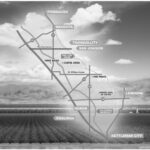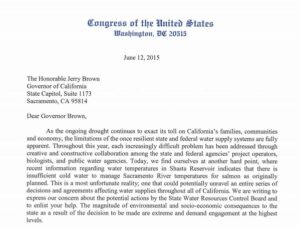Groundwater |
|
From: Lesley Stahl, CBS News
It’s been said that the wars of the 21st century may well be fought over water. The Earth’s population has more than doubled over the last 50 years and the demand for fresh water — to drink and to grow food — has surged along with it. But sources of water like rainfall, rivers, streams, reservoirs, certainly haven’t doubled. So where is all that extra water coming from? More and more, it’s being pumped out of the ground. Coalition response… We applaud 60 Minutes for discussing the important issue of groundwater depletion. However, the report missed a very important factor relative to California – the amount of water taken from food production to prop up failing environmental policies. Thanks to the Endangered Species Act over a million acre-feet of water per year that was once used to grow food now flows to the Pacific Ocean with no measurable environmental benefit. For some it has been a 20-year drought brought on by misguided environmental regulations. Failed government policies are having the effect of making farmers MORE dependent on groundwater rather than less. It’s not surprising that they’re pumping groundwater to stay in business. The same thing happened a century ago and it was the federal and State water projects that put a halt to groundwater overdraft by providing plentiful surface water supplies. Many farmers today no longer have the reliable water supplies that were once delivered by these projects. That will ultimately affect consumers with fewer choices and higher prices at the grocery store.There might be a tradeoff if vulnerable fish species were recovering but they’re not. That’s because the real causes of fish death aren’t being addressed, such as overfishing, invasive species and undertreated wastewater discharges into California’s largest estuary, the Sacramento-San Joaquin Delta. Instead federal environmental water managers are treating the problem by dumping more and more water into a system that isn’t responding because it’s the wrong solution. Agricultural and urban water suppliers are required to complete efficient water management plans to assure that water is being used as efficiently as possible. It’s time that environmental water managers do the same.
|
Other News |
Water Supply |
|
From: Bob Egelko, San Francisco Chronicle
The U.S. Supreme Court on Monday allowed environmentalists to challenge the government’s renewal of 41 long-term contracts for irrigation water from the Sacramento-San Joaquin Delta, in a lawsuit seeking greater protection for the endangered delta smelt.Water districts had asked the justices to review a ruling in April by a federal appeals court in San Francisco. That ruling reinstated a suit by the Natural Resources Defense Council and other groups claiming the U.S. Bureau of Reclamation should have consulted with government biologists before renewing contracts with farms and water districts for as long as 40 years. The justices denied the districts’ request on Monday. |
Drought |
|
From: Matthew Green, KQED
Despite a few recent downpours, California remains stuck in one of the most severe statewide droughts on record.But it’s far from just California’s problem. The state produces a huge percentage of the nation’s agriculture – nearly half of all fruits, vegetables and nuts, by some estimates. And that requires a massive amount of water: farms here use about 80 percent of the state’s developed water supply. |
|
From: Reed Fujii, Stockton Record
California’s almond crop is smaller than expected, hurt by the state’s ongoing drought, while the predictions of a record walnut harvest seems to be coming true, industry experts said.But in both cases, laws of supply and demand, and in particular shifts in global market conditions, have led to softening prices. Almonds and walnuts are San Joaquin County’s top two cash crops, together valued at more than $900 million in 2013. Both are heavily exported. |
Groundwater |
|
From: Angela Greenwood, KGPE A “60 Minutes” piece is drawing some sharp criticism from parts of the local agriculture community. The 13-minute report detailed issues with groundwater and how quickly it’s drying up. It focused largely on the Central Valley and the surge in well drilling, but some are taking issue with the report. The 60 Minutes report titled ‘Water’ aired Sunday night highlighting critical water issues around the country, the world and most specifically right here in the Central Valley. Fresno County based well driller Steve Arthur was among those interviewed for the piece but when he watched it on TV, he says he wasn’t very happy. |
|
From: Denise Robbins, Media Matters For America
A 60 Minutes report on groundwater depletion brought attention to a critical issue that many regard as a national security threat, but failed to mention the inherent connection between water scarcity and climate change.The November 16 edition of 60 Minutes featured a segment on the threat of groundwater scarcity titled “Depleting the Water.” In it, host Leslie Stahl covered the severe droughts around the world that are leading people to extract fresh water from the ground at unsustainable rates, warning that “the wars of the 21st century may well be fought over water.” |
Bay Delta Conservation Plan |
|
From: Scott Smith, Associated Press
A huge conservation project that includes building two massive tunnels to carry water to California farms and communities can only be funded if local water agencies agree to make fixed payments – even during dry periods when deliveries are reduced, state officials said Friday.The information was provided as the state treasurer’s office released a financing plan for the proposed Bay Delta Conservation Project. The treasurer’s independent study offered no opinion on whether the project should be built but said the tunnels would only be feasible if water agencies adopted set annual payments. |
|
From: Sharon Bernstein, Reuters
California farmers would pay more to irrigate their crops under a proposal to build tunnels under the San Joaquin-Sacramento River Delta to funnel water to the state’s agricultural breadbasket, officials said on Friday.The analysis released by state Treasurer Bill Lockyer said regional water suppliers and the farmers who purchase water from them would be able to handle the increased costs, even though the price of water could more than double once the price of paying for the project is included. |
|
From: David Bienick, KCRA
Customers of California’s proposed twin-tunnel water project would have to make billions of dollars in fixed payments each year, even during dry periods when water levels run low, state officials said Friday. The information was provided as the state treasurer’s office released a financing plan for the $25 billion Bay Delta Conservation Project and said it would only be feasible if water agencies adopted a set yearly payment plan.”The conclusion that we reached is that it’s affordable, both on the agricultural side and on what’s called the municipal and industrial side,” said Tim Gage, one of the consultants hired to conduct the study. |
|
From: Staff, KXTV
Everyone from Silicon Valley to Southern California, and farmers in between, depend on water from the San Joaquin Delta. The proposal for two enormous tunnels through the San Joaquin Delta may be the next big water war in California.Gov. Jerry Brown’s plan is to build two tunnels that are 40 feet wide and 30 miles long to carry Sacramento River water to Southern California. Barbara Barrigan-Parrilla, executive director of the Restore the Delta coalition, opposes the plan. |
|
From: Peter Fimrite, San Francisco Chronicle
California’s plan to build tunnels and siphon huge amounts of water from the delta will jack up costs for water users, including 3 million Bay Area residents, but farmers will be hit the hardest, according to a financial analysis released Friday.The report, by state Treasurer Bill Lockyer, says costs could double for some water customers if the Bay Delta Conservation Plan goes through, but it concludes that the overall $25 billion price tag is “within the range of urban and agricultural users’ capacity to pay.” |
Fisheries |
|
From: Sharon Bernstein, Reuters
The annual fall migration of Chinook salmon has been delayed by warmer water temperatures and slow-flowing streams in parts of California as the state’s three-year drought drags on, hatchery officials said Monday.Cool November temperatures usually bring thousands of adult salmon from the Pacific Ocean into streams and rivers to spawn. But this year, fish have been slow to migrate up the American River to the state’s hatchery near Sacramento, said William Cox, manager of the fish production and distribution program at the California Department of Fish and Wildlife. |
Farming News |
|
From: David Willis, BBC I have a neighbour, Deborah, and ever since I’ve lived here, her front lawn has been luxuriant and green. But wandering by the other day I did a double take. Mounds of earth were piled up where the grass had once been, and an army of workmen had set about installing succulent plants and ground cover, and the kind of prickly cactus you normally see in children’s cartoons. By the time Deborah had finished explaining why she was doing it, I could hardly believe I hadn’t done the same thing myself. |
|
From: Alex Breitler, Stockton Record In the very place where the verdant Valley meets the dry, rolling foothills, longtime farmer Kenny Watkins climbed out of his truck one morning last week to examine an orchard of peach trees planted just last February. The trees are already taller than the farmer. “It’s virgin ground,” Watkins said. “Just unbelievable.” During this drought, much has been written about the rapid conversion of vegetable row crops to more profitable fruit and nut orchards, given California’s tenuous water supply. |

